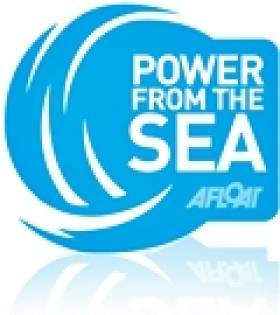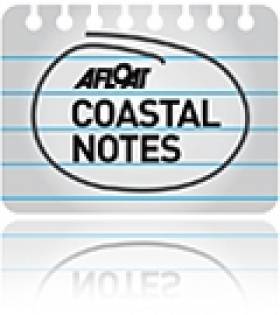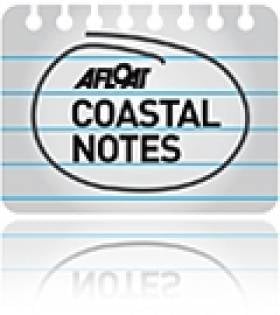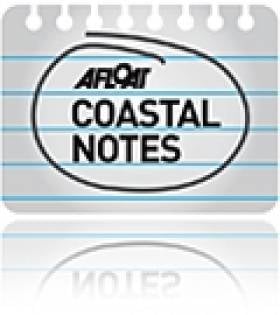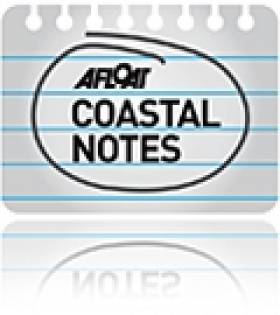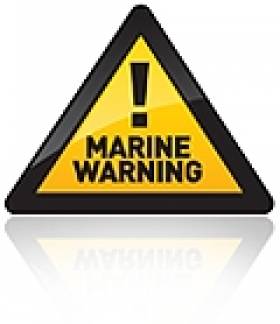Displaying items by tag: Oil exploration
High-Tech Green Seismic Vessel in Cork Harbour Prior to Largest Ever Oil-Gas Off-Shore Irish 3D Survey
#OilExploration – Polarcus Amani, claimed to be one of the most greenest seismic vessels in the world is to embark on one of the largest ever 3D seismic surveys offshore of Ireland reports Cork Harbour.ie
The ultra-modern, super high ice-class, 3D seismic vessel which visited Foynes last year has returned to Irish waters. She is a design from the Norwegian based Ulstein Group which has incorporated a wealth of environmental features on the vessel completed in 2012 which is to tow a seismic array behind of approximately 1.4 km width by 8 km length.
The focus of the survey is in the southern Porcupine Basin, where Polarcus will acquire a minimum area of 4,300 km2, providing coverage over Providence Resources' Drombeg exploration prospect and adjacent acreage on offer in the 2015 Atlantic Margin Oil and Gas Exploration Licensing Round.
As previouly reported on Afloat.ie, Minister for Communications, Energy and Natural Resources, Pat Rabbitte T.D. at the recent Our Ocean Wealth conference announced taxation provisions relating to petroleum exploration and production are to be revised upwards to provide for an increased financial return to the State from discoveries made under future exploration licences and licensing options.
Also reported on Afloat.ie, Cork Harbour is strategically placed as an exploration base for the oil and gas energy industry with potential resources within our territorial waters.
Existing facilities such as the ship repair and maintenance could be expanded to be part of this sector.
Since the foundation of the Irish Maritime and Energy Resource Cluster (IMERC) located in Ringaskiddy, the cluster is the epicentre in promoting Ireland as a world-renowned research centre to unlock our maritime and energy potential.
Highly-specialised vessels such as those from the Polarcus fleet can use the natural harbour as a base for loading supplies, equipment and take on bunkers, where tanker Mersey Spirit is also berthed today at Ringaskiddy deepwater berth.
French Guiana Well is Dry Says Tullow Oil
#Oil - Tullow Oil's shares dropped more than 6% in London trading early last week with the news that its prospect in the Atlantic off French Guiana is dry, according to The Irish Times.
The Irish-founded oil exploration firm says it encountered a number of oil shows in reservoir quality sands at its Zaedyus-2 well in the waters north of Brazil, but it "did not encounter commercial hydrocarbons".
The result was described as "very disappointing" by Investec Securities analyst Stuart Joyner - though better signs have been seen at the nearby Zaedyus-1 well, drilled by Tullow with partners Royal Dutch Shell and Total at a cost of $250 million.
And as previously reported on Afloat.ie, the UK-based company's prospects off the Ivory Coast and Ghana have proven encouraging for future exploration.
Fastnet Oil Plans Celtic Sea's Biggest Seismic Survey
#OIL - Fastnet Oil & Gas will spend more than €20 million on the Celtic Sea's biggest ever seismic study, the Irish Independent reports.
The company was recently awarded two blocks in the waters south of Ireland which were drilled in the 1980s and subsequently abandoned.
But new techniques in the oil industry are allowing previously unviable resources to be extracted - as Petrel Resources are planning to do off the Kerry coast, following the discovery of enormous oil reserves in the Porcupine Basin.
And the Celtic Sea in particular has already attracted attention after Providence Resources announced its discovery of oil reserves at its Barryroe prospect potentially worth billions of euros.
Fastnet Oil, chaired by Cathal Friel, is currently in discussions with major oil groups with a view to sharing the costs of the seismic survey.
Oil Field Off Kerry Could Produce One Billion Barrels
#KERRY OIL - Oil exploration firm Petrel Resources has announced it has found as much as one billion barrels of oil off the coast of Co Kerry.
The Irish Independent reports on the findings by the Dublin-based company which show enormous reserves of oil in the Porcupine Basin off the south-west coast.
As previously reported on Afloat.ie, the company said in September that it has identified a number of targets across the more than 1,400 sq km area of the Atlantic Ocean west of Dursey Island.
Technical studies conducted then on blocks in the northern and eastern parts of the basin for reservoir sands were described as "encouraging".
Now Petrel says that computer analysis shows several oil fields stacked in layers that could be tapped by a smaller number of oil wells.
The distance from shore - approximately 200km - plus the location of the oil reserves beneath 1km of water and a further 3km of rock present some difficulties, but new techniques in the oil industry are allowing previously undrillable resources to be extracted.
Petrel Resources is seeking a partner to invest in drilling for oil, and is preparing its application to the Government for a licence.
The Irish Independent has more on the story HERE.
New Targets for Oil Exploration Off Southwest Coast
#COASTAL NOTES - Oil exploration company Petrel Resources has identified a number of new targets off the southwest coast of Ireland as it seeks bigger partners for its venture.
The Irish Times reports that the Dublin-based firm was awarded licensing options over 1,400 sq km of the Porcupine Basin or Porcupine Blight in the Atlantic Ocean, west of Dursey Island in Co Kerry.
It has since completed two phases of work in the area, and says technical studies of its blocks in the northern and eastern parts of the basin, where is is testing for the presence of reservoir sands, were "encouraging".
The announcement comes following the success of Providence Resources' prospect in the Celtic Sea off the south coast.
As previously reported on Afloat.ie, the Barryroe field may deliver in excess of 2 billion barrels of oil, a flow expected to be worth billions of euro to the Irish economy in future years.
The Irish Times has more on the story HERE.
#COASTAL NOTES - Providence Resourses has announced that its Barryroe oil field off the south coast may be as much as four times larger than anticipated, according to The Irish Times.
Afloat.ie previously reported on the Irish mineral exploration group's discovery in April this year, when the company confirmed the presence of light oil with an appraisal well at the site in the north Celic Sea.
Then on 15 March the firm announced that oil had begun to flow successfully from the Barryroe structure at a rate that could be worth billions of euro to the Irish economy.
The latest news suggests it could be worth even more over a longer period of time, as data compiled from six test wells on the site along with seismic data have led experts to estimate the field contains between 1 and 1.6 billion barrels of oil.
“It is clear that Barryroe is a substantial oil accumulation across multiple stacked horizons with much running room for further resource growth," said Providence chief executive Tony O'Reilly Jr.
The company also expects to begin explorations off Dalkey Island in Co Dublin by the end of the year, pending approval of its foreshore permit.
The so-called 'Dalkey Island prospect' has sparked much debate about its potential risks and benefits among the local community.
Tullow Strikes Oil in West Africa Prospect
#DEEPWATER OIL - Tullow Oil has struck oil off the Ivory Coast in an encouraging development for the Irish-founded oil exploration company, Bloomberg reports.
The UK-based firm says its Paon-1X deepwater exploration well encountered 31 metres of net oil in a gross interval of 74 metres of turbidite sands, suggesting that the well is a continuous column of light oil.
The discovery, which extends recent finds made in nearby Ghana, is "encouraging for our future exploration efforts" says Tullow Oil's Angus McCoss.
Tullow's shares rose 2.1% on the London stock exchange at the news earlier this month. Bloomberg has more on the story HERE.
The firm's successes in West Africa have been reflected closer to home by competing oil exploration business Providence Resources, which recently struck it lucky off the south coast of Cork with an oil flow that could be worth billions of euro to the Irish economy.
As previously reported on Afloat.ie, oil started to flow successfully from the company's Barryroe structure in the north Celtic Sea one month after confirming the presence of light oil with its first appraisal well.
Exxon Mobil Survey off Kerry Coast
Oil exploration company Exxon Mobil will begin exploring underwater areas off Ireland's South West coast this June, with a three-week stint in the area planned. The area they will be surveying is close to recently-discovered areas of rare deep-water coral on the Porcupine slopes.
A notice to mariners on the Department of Transport's website reads:
The Department of Transport would like to advise that ExxonMobil Exploration & Production Ireland (Offshore) Ltd will be carrying out a site survey off the Southwest Coast of Ireland as highlighted in the attached map. The seismic vessel “M/V FUGRO MERIDIAN – C6QR4” is scheduled to carry out the work. The vessel will tow 1 x 3km-long streamer, and will have a minimum turning radius of 2 km. The survey vessel will be restricted in her ability to manoeuvre whilst carrying out the survey and all vessels are requested to give this operation a wide berth. The vessel will be listening on VHF CH 16 throughout the project.
The works are expected to commence in early June 2010 and last for 3 - 4 weeks approximately subject to weather.
Latitude Longitude
51° 20' 49.351" 12° 35' 32.935"
51° 24' 56.106" 12° 25' 57.046"
51° 18' 55.191" 12° 19' 24.114"
51° 14' 49.282" 12° 28' 59.106"
The full notice is downloadable here as a pdf file, with a map of the area included therein.


























